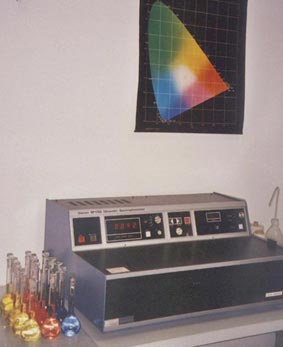|
Name of equipment: |
Spectrophotometer Pye Unicam |
|
Purpose: |
Pye Unicam spectrophotometer have working range of 190-850nm, i.e. it covers UV, VIS and closely IR range. It is aimed for measuring dissolved samples and solid fabrics using appropriate sample holder. |
|
Model, type, country of origin: |
SP 1750, Pye Unicam, UK |
|
Technical characte-ristics: |
Measuring range: 190 – 850 nm
Accuracy: ±0,5 nm Power supply: 200-250 V, 50Hz Dimension of sample area: 20,6 x 22, 8 x 13, 4 cm Dimension of machine: 78,6 x 55, 4 x 33,2 cm |
| Year of origin: –
Figure:
|
|
|
Method of |
Spectrophotometer analyses electromagnetic spectrum. Spectrophotometer is composed of radiation source, monochromator and detector. Monochromator is calibrated in way that is possible to change wavelenght of radiation that pass through. The spectrum is evolved by recording intensity of the radiation which sample has absorbed, missed or reflected depending on wavelenght. |
|
Department, |
Department for Textile Chemistry and Ecology, PhD Research Cabinet, Savska cesta 16/9 |
| Addition note: The corresponding standards: ISO 105 – Tests for colour fastness HRN EN ISO 105-B06; Textiles — Tests for colour fastness — Part B06: Colour fastness and ageing to artificial light at high temperatures: Xenon arc fading lamp tests (ISO 105-B06:1998, including Amendment 1:2002; EN ISO 105-B06:2004) HRN EN ISO 105-C12; Textiles — Tests for colour fastness — Part C12: Colour fastness to industrial laundering (ISO 105-C12:2004; EN ISO 105-C12:2006) HRN EN ISO 105-E05; Textiles — Tests for colour fastness — Part E05: Colour fastness to spotting: Acid (ISO 105-E05:2006; EN ISO 105-E05:2006) HRN EN ISO 105-E06; Textiles — Tests for colour fastness — Part E06: Colour fastness to spotting: Alkali (ISO 105-E06:2006; EN ISO 105-E06:2006) HRN EN ISO 105-G01/AC; Textiles — Tests for colour fastness — Part G01: Colour fastness to nitrogen oxides (ISO 105-G01:1993; EN ISO 105-G01:1995/AC:1996) HRN EN ISO 105-J03; Textiles — Tests for colour fastness — Part J03: Calculation of colour differences (ISO 105-J03:1995, including Technical Corrigendum 1:1996; EN ISO 105-J03:1997) HRN EN ISO 105-N05; Textiles — Tests for colour fastness — Part N05: Colour fastness to stoving (ISO 105-N05:1993; EN ISO 105-N05:1995) HRN EN ISO 105-P01; Textiles — Tests for colour fastness — Part P01: Colour fastness to dry heat (excluding pressing) (ISO 105-P01:1993; EN ISO 105-P01:1995) HRN EN ISO 105-P02; Textiles — Tests for colour fastness — Part P02: Colour fastness to pleating: Steam pleating (ISO 105-P02:2002; EN ISO 105-P02:2004) HRN EN ISO 105-S03; Textiles — Tests for colour fastness — Part S03: Colour fastness to vulcanization: Open steam (ISO 105-S03:1993; EN ISO 105-S03:1995) HRN EN ISO 105-X07; Textiles — Tests for colour fastness — Part X07: Colour fastness to cross-dyeing: Wool (ISO 105-X07:1994; EN ISO 105-X07:1997) HRN EN ISO 105-X10; Textiles — Tests for colour fastness — Part X10: Assessment of migration of textile colours into polyvinyl chloride coatings (ISO 105-X10:1993; EN ISO 105-X10:1995) HRN EN ISO 105-Z05; Textiles — Tests for colour fastness — Part Z05: Determination of the dusting behaviour of dyes (ISO 105-Z05:1996; EN ISO 105-Z05:1998 HRN EN 471:2003; Warning clothes visible from a great distance for professional use – Testing methods and requirements |
|

